Release 2 (8.1.6)
Part Number A76960-01
Library |
Product |
Contents |
Index |
| Oracle8i Distributed Database Systems Release 2 (8.1.6) Part Number A76960-01 |
|
This chapter describes what distributed transactions are and how Oracle8i maintains their integrity. Topics include:
A distributed transaction includes one or more statements that, individually or as a group, update data on two or more distinct nodes of a distributed database. For example, assume the database configuration depicted in Figure 4-1:
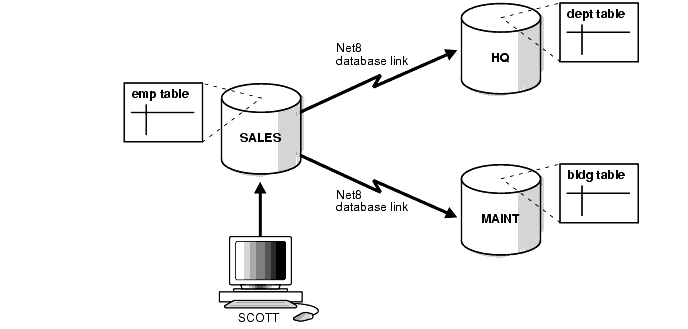
The following distributed transaction executed by SCOTT updates the local SALES database, the remote HQ database, and the remote MAINT database:
UPDATE scott.dept@hq.us.acme.com SET loc = 'REDWOOD SHORES' WHERE deptno = 10; UPDATE scott.emp SET deptno = 11 WHERE deptno = 10; UPDATE scott.bldg@maint.us.acme.com SET room = 1225 WHERE room = 1163; COMMIT;
The section contains the following topics:
This section describes permissible operations in distributed transactions:
The following list describes DML and DDL operations supported in a distributed transaction:
You can execute DML and DDL statements in parallel, and INSERT direct load statements serially, but note the following restrictions:
The following list describes supported transaction control statements:
Oracle8i defines a session tree of all nodes participating in a distributed transaction. A session tree is a hierarchical model of the transaction that describes the relationships among the nodes that are involved. Each node plays a role in the transaction. For example, the node that originates the transaction is the global coordinator, and the node in charge of initiating a commit or rollback is called the commit point site.
|
See Also:
"Session Trees for Distributed Transactions" for an explanation of session trees, and "Distributed Transaction Processing: Case Study" for an example of a session tree. |
Unlike a transaction on a local database, a distributed transaction involves altering data on multiple databases. Consequently, distributed transaction processing is more complicated, because Oracle must coordinate the committing or rolling back of the changes in a transaction as a self-contained unit. In other words, the entire transaction commits, or the entire transactions rolls back.
Oracle ensures the integrity of data in a distributed transaction using the two-phase commit mechanism. In the prepare phase, the initiating node in the transaction asks the other participating nodes to promise to commit or roll back the transaction. During the commit phase, the initiating node asks all participating nodes to commit the transaction; if this outcome is not possible, then all nodes are asked to roll back.
As the statements in a distributed transaction are issued, Oracle8i defines a session tree of all nodes participating in the transaction. A session tree is a hierarchical model that describes the relationships among sessions and their roles. Figure 4-2 illustrates a session tree:
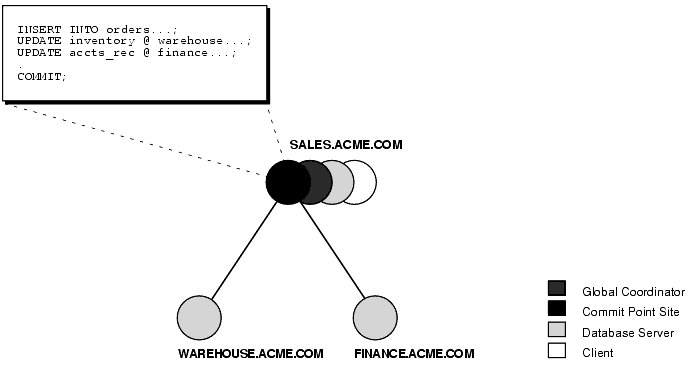
All nodes participating in the session tree of a distributed transaction assume one or more of the following roles:
The role a node plays in a distributed transaction is determined by:
A node acts as a client when it references information from another node's database. The referenced node is a database server. In Figure 4-2, the node SALES is a client of the nodes that host the WAREHOUSE and FINANCE databases.
A database server is a node that hosts a database from which a client requests data.
In Figure 4-2, an application at the SALES node initiates a distributed transaction that accesses data from the WAREHOUSE and FINANCE nodes. Therefore, SALES.ACME.COM has the role of client node, and WAREHOUSE and FINANCE are both database servers. In this example, SALES is a database server and a client because the application also requests a change to the SALES database.
A node that must reference data on other nodes to complete its part in the distributed transaction is called a local coordinator. In Figure 4-2, SALES is a local coordinator because it coordinates the nodes it directly references: WAREHOUSE and FINANCE. SALES also happens to be the global coordinator because it coordinates all the nodes involved in the transaction.
A local coordinator is responsible for coordinating the transaction among the nodes it communicates directly with by:
The node where the distributed transaction originates is called the global coordinator. The database application issuing the distributed transaction is directly connected to the node acting as the global coordinator. For example, in Figure 4-2, the transaction issued at the node SALES references information from the database servers WAREHOUSE and FINANCE. Therefore, SALES.ACME.COM is the global coordinator of this distributed transaction.
The global coordinator becomes the parent or root of the session tree. The global coordinator performs the following operations during a distributed transaction:
The job of the commit point site is to initiate a commit or roll back operation as instructed by the global coordinator. The system administrator always designates one node to be the commit point site in the session tree by assigning all nodes a commit point strength. The node selected as commit point site should be the node that stores the most critical data.
Figure 4-3 illustrates an example of distributed system, with SALES serving as the commit point site:
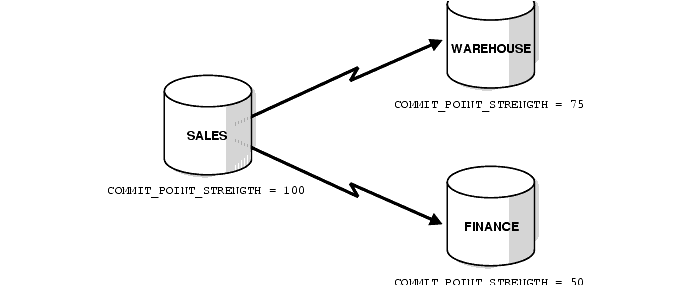
The commit point site is distinct from all other nodes involved in a distributed transaction in these ways:
A distributed transaction is considered committed after all non-commit point sites are prepared, and the transaction has been actually committed at the commit point site. The online redo log at the commit point site is updated as soon as the distributed transaction is committed at this node.
Because the commit point log contains a record of the commit, the transaction is considered committed even though some participating nodes may still be only in the prepared state and the transaction not yet actually committed at these nodes. In the same way, a distributed transaction is considered not committed if the commit has not been logged at the commit point site.
Every database server must be assigned a commit point strength. If a database server is referenced in a distributed transaction, the value of its commit point strength determines which role it plays in the two-phase commit. Specifically, the commit point strength determines whether a given node is the commit point site in the distributed transaction and thus commits before all of the other nodes. This value is specified using the initialization parameter COMMIT_POINT_STRENGTH.
The commit point site, which is determined at the beginning of the prepare phase, is selected only from the nodes participating in the transaction. The following sequence of events occurs:
Figure 4-4 shows in a sample session tree the commit point strengths of each node (in parentheses) and shows the node chosen as the commit point site:
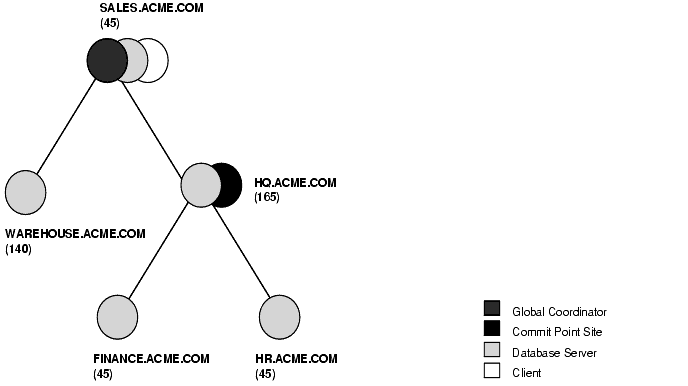
The following conditions apply when determining the commit point site:
As Figure 4-4 illustrates, the commit point site and the global coordinator can be different nodes of the session tree. The commit point strength of each node is communicated to the coordinators when the initial connections are made. The coordinators retain the commit point strengths of each node they are in direct communication with so that commit point sites can be efficiently selected during two-phase commits. Therefore, it is not necessary for the commit point strength to be exchanged between a coordinator and a node each time a commit occurs.
|
See Also:
"Specifying the Commit Point Strength of a Node" to learn how to set the commit point strength of a node, and Oracle8i Reference for more information about the initialization parameter COMMIT_POINT_STRENGTH. |
All participating nodes in a distributed transaction should perform the same action: they should either all commit or all perform a rollback of the transaction. Oracle8i automatically controls and monitors the commit or rollback of a distributed transaction and maintains the integrity of the global database (the collection of databases participating in the transaction) using the two-phase commit mechanism. This mechanism is completely transparent, requiring no programming on the part of the user or application developer.
The commit mechanism has the following distinct phases, which Oracle performs automatically whenever a user commits a distributed transaction:
This section contains the following topics:
The first phase in committing a distributed transaction is the prepare phase. In this phase, Oracle does not actually commit or roll back the transaction. Instead, all nodes referenced in a distributed transaction (except the commit point site, described in the "Commit Point Site") are told to prepare to commit. By preparing, a node:
When a node responds to the global coordinator that it is prepared to commit, the prepared node promises to either commit or roll back the transaction later--but does not make a unilateral decision on whether to commit or roll back the transaction. The promise means that if an instance failure occurs at this point, the node can use the redo records in the online log to recover the database back to the prepare phase.
|
Note: Queries that start after a node has prepared cannot access the associated locked data until all phases complete. The time is insignificant unless a failure occurs (see "Deciding How to Handle In-Doubt Transactions"). |
When a node is told to prepare, it can respond in the following ways:
When a node has successfully prepared, it issues a prepared message. The message indicates that the node has records of the changes in the online log, so it is prepared either to commit or perform a rollback. The message also guarantees that locks held for the transaction can survive a failure.
When a node is asked to prepare, and the SQL statements affecting the database do not change the node's data, the node responds with a read-only message. The message indicates that the node will not participate in the commit phase.
There are three cases in which all or part of a distributed transaction is read-only:
Note that if a distributed transaction is set to read-only, then it does not use rollback segments. If many users connect to the database and their transactions are not set to READ ONLY, then they allocate rollback space even if they are only performing queries.
When a node cannot successfully prepare, it performs the following actions:
These actions then propagate to the other nodes involved in the distributed transaction so that they can roll back the transaction and guarantee the integrity of the data in the global database. This response enforces the primary rule of a distributed transaction: all nodes involved in the transaction either all commit or all roll back the transaction at the same logical time.
To complete the prepare phase, each node excluding the commit point site performs the following steps:
These actions guarantee that the node can subsequently commit or roll back the transaction on the node. The prepared nodes then wait until a COMMIT or ROLLBACK request is received from the global coordinator.
After the nodes are prepared, the distributed transaction is said to be in-doubt (see "In-Doubt Transactions"). It retains in-doubt status until all changes are either committed or rolled back.
The second phase in committing a distributed transaction is the commit phase. Before this phase occurs, all nodes other than the commit point site referenced in the distributed transaction have guaranteed that they are prepared, that is, they have the necessary resources to commit the transaction.
The commit phase consists of the following steps:
When the commit phase is complete, the data on all nodes of the distributed system is consistent with one another.
Each committed transaction has an associated system change number (SCN) to uniquely identify the changes made by the SQL statements within that transaction. The SCN functions as an internal Oracle timestamp that uniquely identifies a committed version of the database.
In a distributed system, the SCNs of communicating nodes are coordinated when all of the following actions occur:
Among other benefits, the coordination of SCNs among the nodes of a distributed system ensures global read-consistency at both the statement and transaction level. If necessary, global time-based recovery can also be completed.
|
See Also:
"Managing Read Consistency" for information about managing time lag issues in read consistency. |
During the prepare phase, Oracle8i determines the highest SCN at all nodes involved in the transaction. The transaction then commits with the high SCN at the commit point site. The commit SCN is then sent to all prepared nodes with the commit decision.
After the participating nodes notify the commit point site that they have committed, the commit point site can forget about the transaction. The following steps occur:
The two-phase commit mechanism ensures that all nodes either commit or perform a rollback together. What happens if any of the three phases fails because of a system or network error? The transaction becomes in-doubt.
Distributed transactions can become in-doubt in the following ways:
The RECO process automatically resolves in-doubt transactions when the machine, network, or software problem is resolved. Until RECO can resolve the transaction, the data is locked for both reads and writes. Oracle blocks reads because it cannot determine which version of the data to display for a query.
This section contains the following topics:
In the majority of cases, Oracle resolves the in-doubt transaction automatically. Assume that there are two nodes, LOCAL and REMOTE, in the following scenarios. The local node is the commit point site. User SCOTT connects to LOCAL and executes and commits a distributed transaction that updates LOCAL and REMOTE.
Figure 4-5 illustrates the sequence of events when there is a failure during the prepare phase of a distributed transaction:
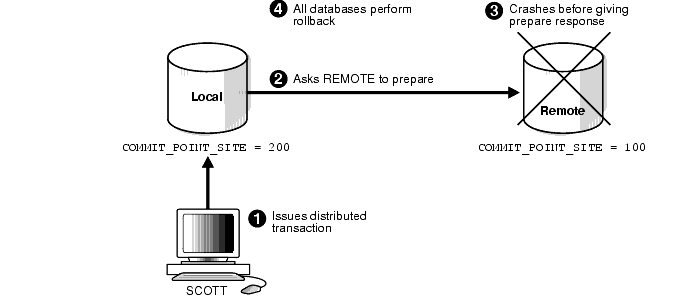
The following steps occur:
Figure 4-5 illustrates the sequence of events when there is a failure during the commit phase of a distributed transaction:
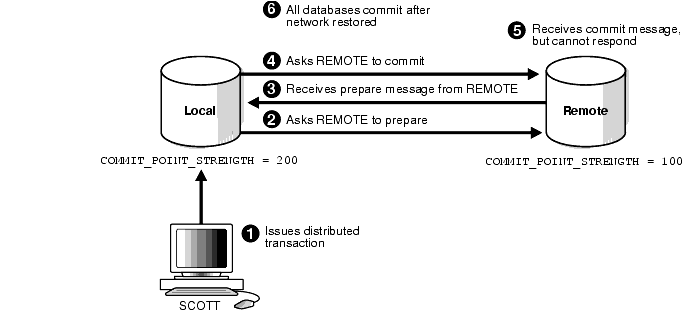
The following steps occur:
"Deciding How to Handle In-Doubt Transactions" for a description of failure situations and how Oracle8i resolves intervening failures during two-phase commit.
See Also:
You should only need to resolve an in-doubt transaction in the following cases:
Resolution of in-doubt transactions can be complicated. The procedure requires that you do the following:
"Deciding How to Handle In-Doubt Transactions" and "Manually Overriding In-Doubt Transactions" to learn how to resolve in-doubt transactions.
See Also:
A system change number (SCN) is an internal timestamp for a committed version of the database. The Oracle database server uses the SCN clock value to guarantee transaction consistency. For example, when a user commits a transaction, Oracle records an SCN for this commit in the online redo log.
Oracle uses SCNs to coordinate distributed transactions among different databases. For example, Oracle uses SCNs in the following way:
SCNs are important for distributed transactions because they function as a synchronized commit timestamp of a transaction--even if the transaction fails. If a transaction becomes in-doubt, an administrator can use this SCN to coordinate changes made to the global database. The global SCN for the transaction commit can also be used to identify the transaction later, for example, in distributed recovery.
In this scenario, a company has separate Oracle8i database servers, SALES.ACME.COM and WAREHOUSE.ACME.COM. As users insert sales records into the SALES database, associated records are being updated at the WAREHOUSE database.
This case study of distributed processing illustrates:
At the Sales department, a salesperson uses SQL*Plus to enter a sales order and then commit it. The application issues a number of SQL statements to enter the order into the SALES database and update the inventory in the WAREHOUSE database:
CONNECT scott/tiger@sales.acme.com ...; INSERT INTO orders ...; UPDATE inventory@warehouse.acme.com ...; INSERT INTO orders ...; UPDATE inventory@warehouse.acme.com ...; COMMIT;
These SQL statements are part of a single distributed transaction, guaranteeing that all issued SQL statements succeed or fail as a unit. Treating the statements as a unit prevents the possibility of an order being placed and then inventory not being updated to reflect the order. In effect, the transaction guarantees the consistency of data in the global database.
As each of the SQL statements in the transaction executes, the session tree is defined, as shown in Figure 4-7.
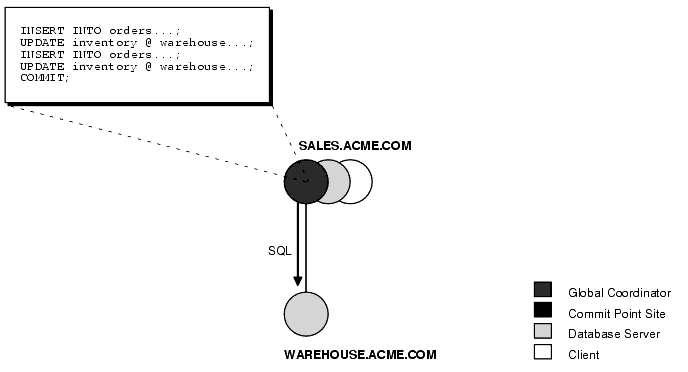
Note the following aspects of the transaction:
This stage completes the definition of the session tree for this distributed transaction. Each node in the tree has acquired the necessary data locks to execute the SQL statements that reference local data. These locks remain even after the SQL statements have been executed until the two-phase commit is completed.
Oracle determines the commit point site immediately following the COMMIT statement. SALES.ACME.COM, the global coordinator, is determined to be the commit point site, as shown in Figure 4-8.
|
See Also:
"Commit Point Strength" for more information about how the commit point site is determined. |
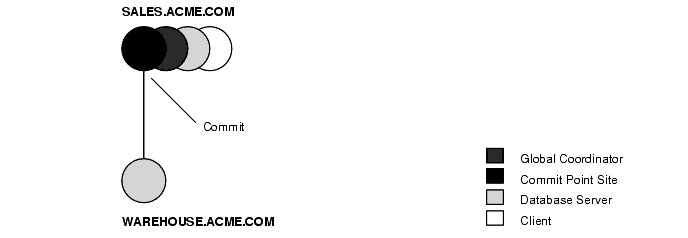
The prepare stage involves the following steps:
As each node prepares, it sends a message back to the node that asked it to prepare. Depending on the responses, one of the following can happen:
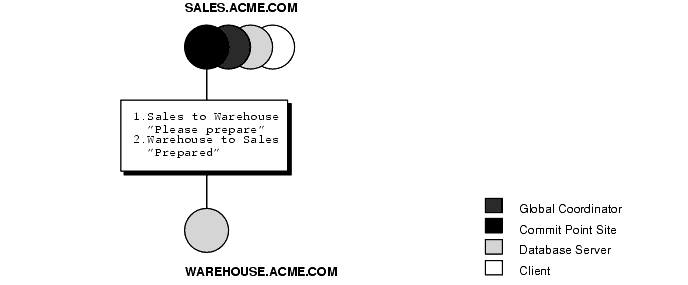
The committing of the transaction by the commit point site involves the following steps:
Even if WAREHOUSE.ACME.COM has not yet committed, the outcome of this transaction is pre-determined. In other words, the transaction will be committed at all nodes even if a given node's ability to commit is delayed.
This stage involves the following steps:
The committing of the transaction by all the nodes in the transaction involves the following steps:
In Figure 4-10, SALES.ACME.COM, which is both the commit point site and the global coordinator, has already committed the transaction locally. SALES now instructs WAREHOUSE.ACME.COM to commit the transaction.
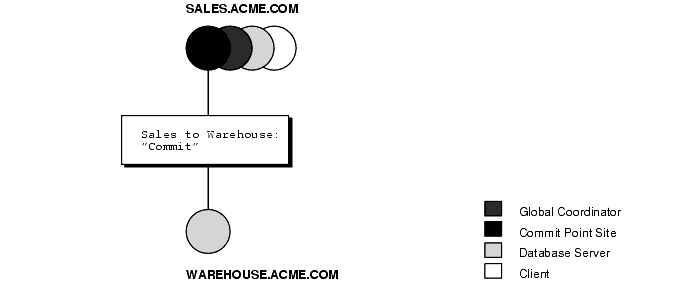
The completion of the commit of the transaction occurs in the following steps:
After the completion of the COMMIT phase, the distributed transaction is itself complete. The steps described above are accomplished automatically and in a fraction of a second.
|
|
 Copyright © 1996-2000, Oracle Corporation. All Rights Reserved. |
|